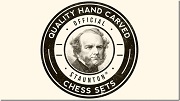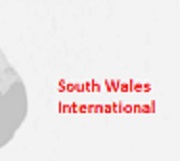The club was founded in 1897. A meeting was convened on Thursday 28th October that year at the Wynnstay Chambers. It is one of the oldest continuous Welsh clubs, having met continuously since its inception, regularly meeting throughout both World Wars.
1897-1927
GROWING PAINS
Pre WW1 the club played matches as they could be arranged against clubs from Llandudno, Wrexham, Bangor, Abergele and Rhyl. The early officers of the club are not known but1904 Francis Nunn is noted as President, E. D. Rowlands, captain and James Stevens secretary. Mr. Stevens, town auctioneer and estate agent, died in February 1906. The club met at this time in the Constitutional Club.
No doubt matches were organised in the period 1897-1907 but no details have come to light and the first match recorded in the press took place in December 1907 against Llandudno. The Colwyn Bay team at this time was: E.D.Rowlands, T. H. Albutt, F. Nunn, W. B. Miller, Wm. Jones and Mrs. Miller. The match was drawn 5½ points each with Llandudno winning on the top boards.
In October 1908, as a result of increasing numbers, the club moved to the Café Royal in Station Road. One of the reasons the club was growing at this time was that the YMCA was also encouraging its members to play matches of chess and draughts against neighbouring towns and no doubt there was a spin-off for the Colwyn Bay club.
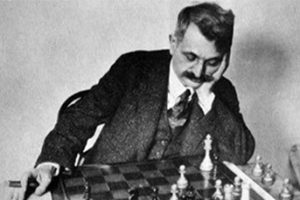
Dr. Emanuel Lasker
On 23rd March 1908, players from Colwyn Bay, Llandudno, Rhyl, Abergele and Shrewbury played in a simultaneous display at the café against the reigning World Champion, Dr. Emmanuel Lasker. The World Champion won 17 and drew 2 games. The event took place at the Café Royal and was organised by the club secretary H. Wills. The final result had a strange twist. J. T. Eachus of Rhyl had to leave early and T. Samuel of Abergele was allowed to take up the game and succeeded in drawing. (See Bridgend history for more on T. Samuel). The other draw went to A. Laserson of Llandudno. Amongst the vanquished was J. E. Parry of Bangor and Shrewsbury, widely regarded as the strongest player in Wales at that time. Twelve of those who participated were from the home club. Lasker gave a short lecture before the display and stated his policy,” First tie your opponent into a knot and then put him into your pocket.” He was reported as hardly ever moving without an interjection of some sort. When he spotted the foury-year-old son of H. Higginsbottom studying the game of Laserson he said, “Now I know where the good moves are coming from. It is hardly fair that Mr. Laserson should take advice from a coming champion.” One player who passed twice as he was not ready to play was met with the remark on the third tour, “Don’t worry it will soon be over”.
In 1908 the North Wales Chess Association was inaugurated and Francis Nunn of Colwyn Bay was elected one of the vice-presidents. Two years later he was President, the position rotating amongst the clubs. T. H. Albutt of Old Colwyn and H. Wills, the Hon. Sec. of Colwyn Bay Chess Club, at the time the biggest club in North Wales, had been the driving force behind the setup. The press was enthusing over chess clubs all across North Wales – Rhyl, Denbigh, Ruthin, Abergele, Conway, Bethesda, Barmouth, Aberdovey, Wrexham, Ruabon, Rhos – and other places!
In 1910 the Chambers Challenge Cup was inaugurated, a Knockout originally featuring Bangor, Wrexham, Ruabon, Llandudno, Rhyl and Colwyn Bay.
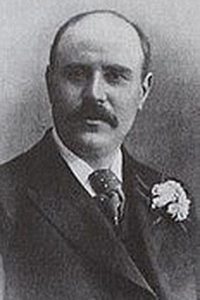
Isidor Gunsberg
On 22nd October 1910, Isidor Gunsberg gave a simultaneous display against the club members, winning on all 11 boards. In the late 1880s and early 1890s Gunsberg was one of the top players in the world, narrowly losing an 1891 World Championship Match 4+ 6- 9= to Wilhelm Steinitz. Harry Evans had taken over secretarial duties at the club and made the arrangements.
No matches were played during the war and the club lost some of its strength. Post WW1 matches were played just locally against Llandudno, Penmaenmawr and Rydal School – once over 20 boards! It wasn’t until 1922 that the Chambers Challenge Cup was restarted. Internally the club held Knockout, Ladder, Handicap and Club Competitions. Consultation matches were played and a loan library was started. On Feb 9th 1922 the new Silver King Trophy – donated by the Club President Lord Colwyn, was exhibited at the club. It was valued at £10 (approx. £500 today).
In 1926 Colwyn Bay won the North Wales Challenge Cup for the first time.
1927-1945
THE GREAT DEPRESSION
The club moved to Amblers Café on Penrhyn Road for three years before returning to the Café Royal in 1930. Three years later the club moved up the road to Gartmells Restaurant. During this period the club membership declined sharply from 40! in 1928, to an all-time low of 8 members due to deaths and the war. Few matches were played. In 1941 the Club beat the Ministry of Food in a match, while in 1942 they drew a match against the Prestatyn Signallers.
1945-1965
A GOLDEN TWENTY YEARS
In the immediate aftermath of the war membership increased sharply and friendly matches were played against Llandudno, Bangor, Abergele, Penmaenmawr, Crossville, Flint, Rhyl and the newly formed Penrhyn Bay Club. In 1949 the North Wales Chess Association was reformed.
In 1950 Colwyn Bay beat Llandudno, Bangor and Flint to lift the N.W.C.A. Trophy. The trophy was retained the following year, beating Llandudno in the final.
In 1951 the club moved to Lowes Café on Station Road. In 1953 the club entered the National Club Competition for the first time, putting up a good show before losing to a strong Liverpool side in the first round. The following year victory over Newcombe was followed by a loss to Wakefield in round 2. The club suffered 1st round losses to Liverpool in 1955, 1958 and 1960 and to Manchester in 1956 and 1959. 1st round successes against Blackburn in 1957 and Warrington in 1961 were followed by losses in round 2 to Manchester, while a 1st round win in 1962 over Capenhurst, came before a loss to Blackpool.
During this period the club also played friendly matches against Rydal and John Bright’s School, Bangor University and Chester YMCA. In 1959 the club started to compete in the Cheshire Cup. In 1959, 1960 and 1963 the club lost to Stockport. The only success came in 1962 with a 1st round win over Capenhurst, before losing to Wallasey. In 1960 Colwyn Bay were the only chess club in existence in North Wales. In 1962 a new North Wales Chess League was formed with Deeside, De Havilland, Mold and Wrexham.
Colwyn Bay had a great season in 1963/64. Liverpool were beaten in the 1st round of the National Club Championship, before the inevitable 2nd round loss to Manchester. Wins followed against Mold and Wrexham in the North Wales League, along with a draw against Deeside. Friendly wins were also achieved against Caernarfon, Bangor, Rydal and Chester. In 1964 Colwyn Bay moved to the Colwyn Bay Hotel. They were the unofficial North Wales champions after beating Bangor University, while they lost to Cardiff in the final of the Welsh cup, playing the match by telephone.
1965-1987
THE SPLITS AND UNSETTLED TIMES
The club suffered a drop in numbers from 1965, losing several members including the club captain Dr Kraus to the newly reformed Rhyl chess Club. In 1967 the club lost to Manchester University in the Cheshire Cup.
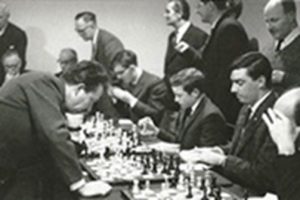
Svetozar Gligoric Simul.
During 1967, Svetozar Gligoric, ranked 12 in the World at the time, gave a 30-board simultaneous display at Chester YMCA. Brendan Shields, a member of Colwyn Bay since he was a schoolboy, was one of the players involved and is seated second from the right in this picture. Brendan was one of only four players who managed a draw – the rest all lost. Brendan, who was 21 at the time, said: “My last train from Chester home to Penmaenmawr was due very soon so I had to ‘be a bit cheeky and offer a draw, not for a minute expecting him to accept. Although my position was quite good I was amazed when he accepted, especially as the number of players left was decreasing quickly! I just about caught the last train from Chester but it only went as far as Llandudno Junction, so I set off to walk to Penmaenmawr. Fortunately, my father picked me up at Conwy Morfa. Anyway, it was worth the walk!” Standing behind Brendan in the picture is Dr E.B. Kraus, a former Colwyn Bay captain who went on to join Rhyl C.C. He also managed a draw.
In 1968 FM Peter Clarke, a Correspondence Grandmaster, England International and 5 times British Championship runner up, gave a 13 board simul, winning all his games.
The club lost to a very strong Liverpool side in the national club championship, while in the Cheshire Cup they beat Hawker Siddley before losing to East Cheshire. In 1969 the club moved to the Liberal Association on Princes Drive. With few members, no matches or internal competitions were played for 3 years. In the 1970 National club championship the club understandably forfeited against Glasgow!
In 1974 the Club moved to St Pauls Institute in Rhiw Road and played matches against Bangor and Tregarth. The following years were quiet in terms of activity, but regular matches were played against Rhyl and Colwyn High School. In 1979 the Club moved to the Prince Madoc Hotel on Station Road. The following year they moved again to the Queens Hotel in Old Colwyn.
In 1980 Welsh Champion Howard Williams gave a simultaneous display winning 18 games and drawing 2.
Matches were played against Rhyl, Rydal, Eirias School and Great Lever. 1981 saw the club move back to the Prince Madoc Hotel. The club entered the North Wales Tournament in the 1983-84 season, beating Rhyl, but losing to Bangor, East Clwyd and Wrexham.
Don Grayson won his 10th Club Championship title, in 11 years. Once rated as high as 195 B.C.F, Don was perhaps the strongest player in the club’s history, playing many years for the club before losing a game.
Colwyn Bay finally joined the Chester and District League for the 1984-85 season, entering in Division 2. They won the division and promotion with a 12+ 2= 2- record. In the K.O. they lost 7.5-0.5 to Wrexham, showing the challenge that awaited them next season in division 1.
In 1985 the club moved to the Green Lawns Hotel in Bay View Road. The club found it tough in Division 1 3+ 3= 12-, but did beat Wrexham 4-3 away. 1986 saw a 2nd team entered in Division 3 of the league.
1987 saw the present venue being unavailable. 2 new venues were found, one in Rhos-on-Sea and the second in Llandudno. After the resulting vote went in favour of the Rhos-on-Sea venue, 4/5 of the committee left to form Llandudno Chess club.
1987-2013
MODERN TIMES
The club moved to St Mary’s School in Rhos-on-Sea. In 1988 the club moved to the Norfolk House Hotel on Princes Drive.
Club President Ralph Stokes was elected President of the Chester and District league.
The team finished 2nd in Division 2 and accepted promotion. In 1989 the club entered The North Wales Cup, losing to eventual winners Wrexham, and also fielded a team in the Gwynedd league. The team finished last in Division 1 of the of the Chester & District league and were relegated. 1990 saw a 2nd team entered in the 4th division, finishing 2nd. They repeated the result for the next 2 seasons. 1991 saw the relegation of the 1st team to Division 3. They won promotion the following year only to be relegated again in 1993. 1996 saw the dropping of the 1st team. The old 2nd team won Division 4. In 2001 the Club moved to the Hopeside Hotel and the chess team’s revival began with promotion from Division 3, with a 12+ 1= 1- record. The club also reached the K.O. final, losing to perennial winners Wrexham. 2002 saw the club again reach the K.O final, this time losing to Caergwrle. The team avoided relegation by winning their final match against Rhyl, a result which saw Rhyl relegated instead. 2003 saw a return to Division 1 after a 13 year absence.
A victory in the K.O. over Rhyl, was followed by a Semi-Final loss to Wrexham. 2004 saw relegation again. Rhyl were once again defeated in the K.O., before a loss to Caergwrle. 2005 saw the club move to The Sea Sports and Social Club in Rhos-on-Sea. The reduced rent meant that for the first time in its history the club could meet through the Summer. The team easily won promotion with a 9+ 1= 1- record. The K.O. produced another first round win, this time over Buckley, before suffering another defeat to Wrexham.
2006 saw the remerging of the Llandudno and Colwyn Bay clubs.
Colwyn Bay were relegated again, but Llandudno were promoted from Division 2 after being relegated the previous year. This meant combined Colwyn Bay/Llandudno sides in both the 1st and 2nd divisions of the league for the following season. 2007 saw the combined club finish 3rd in Division 1 for the first time, with the 2nd team matching the result in Division 2. 2008 saw the 1st team finish in 5th place, but only 1/2 a point away from 2nd. The 2nd team escaped relegation on game points. In both 2009 and 2010 the club again finished 3rd in Division 1. The 2nd team finished 2nd and then 4th in Division 2.
2011 was the most successful year for the club since joining the league. The 1st team finished runners up in Division 1, while the 2nd team won the Division 2 title.
2012 saw the 1st team finish 4th in Division 1. They were joined for the season by Colwyn Bay 2, who had accepted promotion. 2013 saw both teams finish 3rd in their respective divisions. 2014 saw the formation of a 3rd Team and therefore a presence in all 3 divisions of the league. The 3rd team won the Division 3 title, with the 1st and 2nd teams finishing 4th and 6th respectively in Divisions 1 and 2.
Colwyn Bay won the inaugural U145 Bill Davies Cup beating Frodsham in the final.
2015 saw a return to just 2 teams, both of which struggled. The 1sts finished bottom of Division 1 and the 2nds next to bottom of Division 2. The club again reached the final of the U145 Bill Davies Cup before losing to Chester. Colwyn Bay reached the 2016 K.O. final before losing to Malpas and Oswestry.
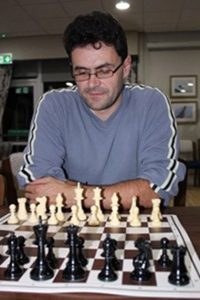
David Jameson of Colwyn Bay Shared the Welsh Championship title in 2018
(Much of the above about Colwyn Bay Chess Club was written by David Jameson and appears on the club website).
RYDAL SCHOOL CHESS CLUB
Rydal Mount School, Colwyn Bay, was opened in 1885 and there are continuous references to chess in the school magazine, The Rydalian. The first reference is in April 1887 and the headmaster, T. G. Osborn, was chess club president with R. C. Hawkin as secretary and J. H. Evans as treasurer. Julius MacDonald was the earliest known winner of a school chess tournament. Books were given as prizes and for the 1900 tournament the prize was J. H. Blackburne’s “Book of Chess”. Until his death in 1908 the deputy headmaster, James Deaville, was club president in the 1900s and T. K. Barnsley was curator of club equipment. The club was revived after the First World War with the support of the headmaster Rev. A. J. Costain.
Chess has always been a popular activity at the school, but the 1920s saw increased activity and the emergence of several strong players among the pupils. The credit for this must be given to Mr. H. A. Smyth, a teacher who was club president. Regular matches were played against UCNW Bangor and Colwyn Bay, and Masters v. Pupils matches were introduced. There was a flourishing inter-house tournament for seniors and juniors in the 1920s and the four ‘houses’ were Trojans, Crusaders, Corinthians and Barbarians. Sir George Thomas in 1921 and Boris Kostic (Serbia) were two champions invited to give simultaneous displays. The only winner on both occasions was Frederick Robert Kay. Other pupils who were strong players at this time were Baker, Waterhouse, Mitchell, Lord, Revnell, Kirkup, Norman, Wigfield, Ellis, Hyde, Darrah, Swallow and Brocklehurst.
The North Wales Chess Association was revived in 1922 and Rydal School won the Association’s Silver Rook trophy in the first year, defeating Rhos in the final. In 1923, Wigfield complained he was distracted by the pipe-smoking of his Rhos opponent! Rydal achieved comparative success against adult sides in North Wales in the inter-war years, and Ian Ainslie went on to become president and champion of Cambridge University chess club in 1933-4.
The centenary register of Rydal School in 1985 records the names of several pupils who have represented their house or school at chess since the last war. The school has achieved notable successes in inter-school matches in recent years. Dafydd Wigley, former MP for Caernarfon, was a pupil at the school in 1959, and his interest in chess prompted his father, Elfyn Wigley, to take a chess team from Caernarfon to play against the school. In the 1980s an old Rydalian, Michael Lee, became secretary of Colwyn Bay chess club and in 1986 Rydal School joined the Chester and District Chess League.
(The above was written by David Castledine and appeared in ’The Cheshire Hundred” in 1988.)
The school today is known as Rydal Penrhos. A star pupil who left in 2019, was Imogen Camp. As a junior she won numerous Welsh titles and became British Champion at Under 15 and Under 16 levels. Still a junior, she gained a Women’s Candidate Master title at the 2016 Olympiad held in Baku, became Welsh Women’s Champion in 2017, and top-scored for Wales at the 2018 Olympiad in Georgia

Imogen Camp
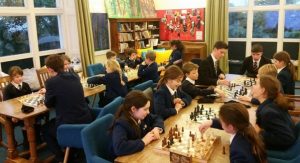
Rydal Penrhos Prep Chess Club 2020




